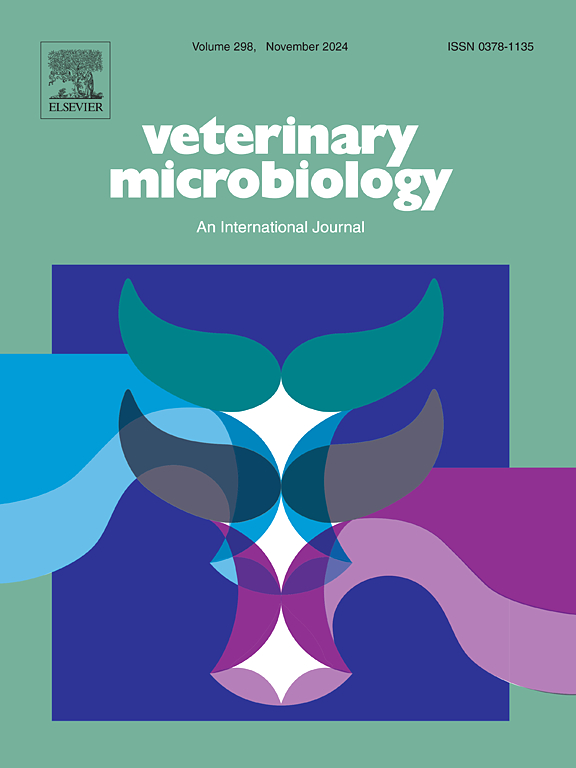ZDHHC3-LYPLA1通过可逆棕榈酰化调控PRRSV-2复制。
IF 2.4
2区 农林科学
Q3 MICROBIOLOGY
引用次数: 0
摘要
猪繁殖与呼吸综合征病毒(PRRSV)是一种高度传染性的猪病原体,可引起仔猪呼吸系统疾病和母猪繁殖失败。含锌指Asp-His-His-Cys (ZDHHC)结构域的棕榈酰转移酶催化的棕榈酰化在病毒感染中起着复杂的作用。然而,棕榈酰化是否调控PRRSV复制尚不完全清楚。在这里,我们报道了2-溴棕榈酸酯(2-BP)抑制棕榈酰化促进PRRSV增殖。在PAMs感染中,ZDHHC3被鉴定为调控PRRSV复制的关键棕榈酰转移酶。机制上,ZDHHC3在半胱氨酸90位点催化核衣壳(N)蛋白棕榈酰化。这种修饰阻止Nsp9-N蛋白相互作用和随后的病毒RNA合成。此外,LYPLA1去棕榈酰化N蛋白,从而抵消ZDHHC3对PRRSV复制的活性。同时,靶向LYPLA1的小分子抑制剂ML348可以抑制PRRSV-2的复制。总之,我们的研究结果强调了可逆棕榈酰化在PRRSV复制中的关键作用。这些发现可能提供潜在的新的抗prrsv策略。本文章由计算机程序翻译,如有差异,请以英文原文为准。
ZDHHC3-LYPLA1 regulates PRRSV-2 replication through reversible palmitoylation
Porcine reproductive and respiratory syndrome virus (PRRSV) is a highly contagious swine pathogen, causing respiratory problems in piglets and reproductive failure in sows. Palmitoylation, catalyzed by zinc finger Asp-His-His-Cys (ZDHHC) domain-containing palmitoyl acyltransferases, plays intricate roles in virus infection. However, whether palmitoylation regulates PRRSV replication is incompletely understood. Here, we report that inhibition of palmitoylation by 2-bromo palmitate (2-BP) promotes PRRSV multiplication. ZDHHC3 is identified as the key palmitoyl transferase regulating PRRSV replication in PAMs infection. Mechanistically, ZDHHC3 catalyzes nucleocapsid (N) protein palmitoylation at cysteine 90. This modification prevents the Nsp9-N protein interaction and subsequent viral RNA synthesis. Furthermore, LYPLA1 de-palmitoylates N protein, thus counteracting the ZDHHC3’s activity on PRRSV replication. Meanwhile, the administration of small-molecule inhibitor ML348 targeting LYPLA1 could hinder PRRSV-2 replication. In summary, our results underscore the critical role of reversible palmitoylation in PRRSV replication. These findings might provide potential new anti-PRRSV strategies.
求助全文
通过发布文献求助,成功后即可免费获取论文全文。
去求助
来源期刊

Veterinary microbiology
农林科学-兽医学
CiteScore
5.90
自引率
6.10%
发文量
221
审稿时长
52 days
期刊介绍:
Veterinary Microbiology is concerned with microbial (bacterial, fungal, viral) diseases of domesticated vertebrate animals (livestock, companion animals, fur-bearing animals, game, poultry, fish) that supply food, other useful products or companionship. In addition, Microbial diseases of wild animals living in captivity, or as members of the feral fauna will also be considered if the infections are of interest because of their interrelation with humans (zoonoses) and/or domestic animals. Studies of antimicrobial resistance are also included, provided that the results represent a substantial advance in knowledge. Authors are strongly encouraged to read - prior to submission - the Editorials (''Scope or cope'' and ''Scope or cope II'') published previously in the journal. The Editors reserve the right to suggest submission to another journal for those papers which they feel would be more appropriate for consideration by that journal.
Original research papers of high quality and novelty on aspects of control, host response, molecular biology, pathogenesis, prevention, and treatment of microbial diseases of animals are published. Papers dealing primarily with immunology, epidemiology, molecular biology and antiviral or microbial agents will only be considered if they demonstrate a clear impact on a disease. Papers focusing solely on diagnostic techniques (such as another PCR protocol or ELISA) will not be published - focus should be on a microorganism and not on a particular technique. Papers only reporting microbial sequences, transcriptomics data, or proteomics data will not be considered unless the results represent a substantial advance in knowledge.
Drug trial papers will be considered if they have general application or significance. Papers on the identification of microorganisms will also be considered, but detailed taxonomic studies do not fall within the scope of the journal. Case reports will not be published, unless they have general application or contain novel aspects. Papers of geographically limited interest, which repeat what had been established elsewhere will not be considered. The readership of the journal is global.
 求助内容:
求助内容: 应助结果提醒方式:
应助结果提醒方式:


